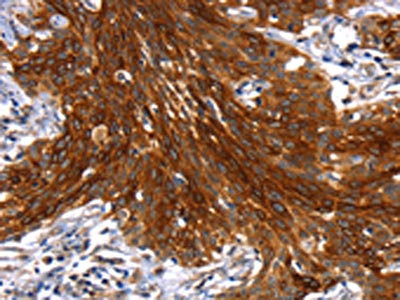
The image on the left is immunohistochemistry of paraffin-embedded Human cervical cancer tissue using CSB-PA208890(MAPK9 Antibody) at dilution 1/30, on the right is treated with synthetic peptide. (Original magnification: x200)
MAPK9 Antibody

CSB-PA208890
ApplicationsWestern Blot, ELISA, ImmunoHistoChemistry
Product group Antibodies
ReactivityHuman
TargetMAPK9
Overview
- SupplierCusabio
- Product NameMAPK9 Antibody
- Delivery Days Customer20
- ApplicationsWestern Blot, ELISA, ImmunoHistoChemistry
- CertificationResearch Use Only
- ClonalityPolyclonal
- ConjugateUnconjugated
- FormulationLiquid
- Gene ID5601
- Target nameMAPK9
- Target descriptionmitogen-activated protein kinase 9
- Target synonymsc-Jun kinase 2; c-Jun N-terminal kinase 2; JNK2; JNK2A; JNK2ALPHA; JNK2B; JNK2BETA; JNK-55; Jun kinase; MAP kinase 9; MAPK 9; mitogen-activated protein kinase 9; p54a; p54aSAPK; PRKM9; SAPK; SAPK1a; stress-activated protein kinase 1a; stress-activated protein kinase JNK2
- HostRabbit
- IsotypeIgG
- Protein IDP45984
- Protein NameMitogen-activated protein kinase 9
- Scientific DescriptionThe protein encoded by this gene is a member of the MAP kinase family. MAP kinases act as an integration point for multiple biochemical signals, and are involved in a wide variety of cellular processes such as proliferation, differentiation, transcription regulation and development. This kinase targets specific transcription factors, and thus mediates immediate-early gene expression in response to various cell stimuli. It is most closely related to MAPK8, both of which are involved in UV radiation induced apoptosis, thought to be related to the cytochrome c-mediated cell death pathway. This gene and MAPK8 are also known as c-Jun N-terminal kinases. This kinase blocks the ubiquitination of tumor suppressor p53, and thus it increases the stability of p53 in nonstressed cells. Studies of this genes mouse counterpart suggest a key role in T-cell differentiation. Several alternatively spliced transcript variants encoding distinct isoforms have been reported.
- ReactivityHuman
- Storage Instruction-20°C or -80°C
- UNSPSC12352203

